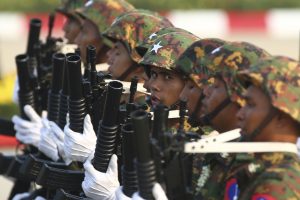The brutal campaign unleashed by the Myanmar military to crush the resistance movement has involved bombings, raids, burning of villages, and massacres of innocent civilians. The atrocities have compelled a large number of people to leave their homes and relocate to safer zones. Buried in these incidents are numerous individual stories of people who narrowly escaped from being apprehended and slaughtered by the military.
The Diplomat tracked five such cases from Myanmar’s Chin State and Sagaing Region, which are among the worst affected zones in the ongoing conflict in Myanmar.
“May the truck driver and his associate live for a thousand years”
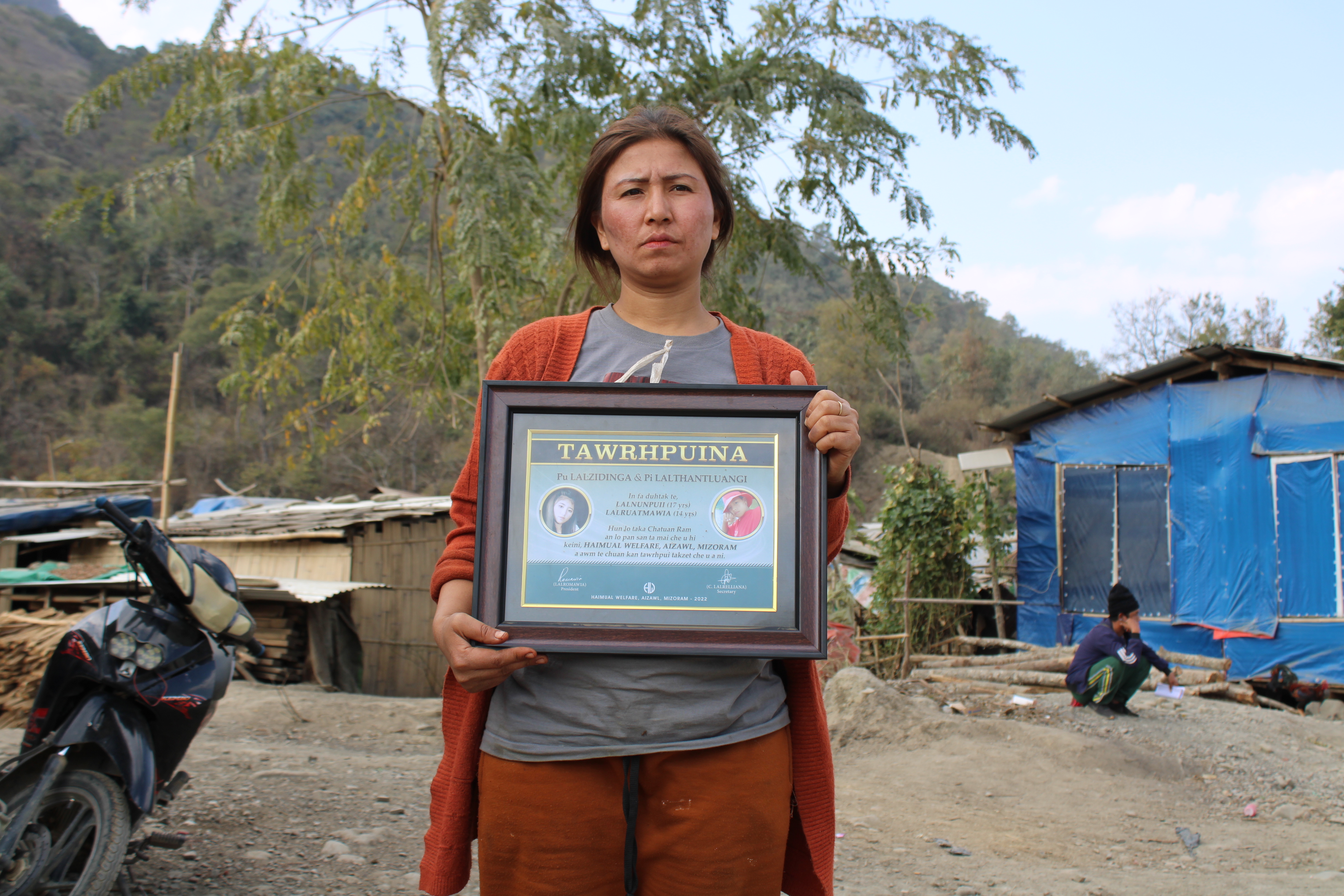
Lalthantluangi holding a condolence plaque at a refugee camp in Zokhawthar, India, that she received from an NGO for her two deceased children killed by the Myanmar junta. Photo by Rajeev Bhattacharyya
On August 14, 2022, regime forces burned 16 houses in the contiguous villages of Haimual and New Haimual in Myanmar’s Chin State. Before launching the operation, army personnel forced 12 residents to assemble in one place. They were to serve as a shield for the military against attacks by the Mountain Eagle Defense Force, the resistance group in the village. They planned to take the group to a nearby military establishment.
The plan did not succeed. The residents escaped, barring two children who were killed.
In the group was a middle-aged woman named Lalthantluangi who now lives at a refugee camp at Zokhawthar in the Indian state of Mizoram, which is 5 miles north of the twin villages in Chin State. In an interview on January 16 at Zokhawthar, she recounted her escape from the military:
“It was in the afternoon on August 14 that a squad of about 50 army personnel came marching to our village. We had a premonition of an attack since fighter aircraft were hovering above on August 11. The personnel barged into some houses and compelled 12 people, including myself and my two teenage children, to sit on the highway adjacent to the village. We could spot two informers with them who were reportedly from Tedim. We sat on the road for two hours with four soldiers pointing their guns at us. The rest went about searching and burning some houses belonging to PDF [People’s Defense Force, the anti-coup resistance forces] functionaries who had already departed from the village ahead of the operation. They had precise information about the houses of some functionaries.
They [regime forces] were extremely furious when no functionary could be apprehended. It was then that they decided to take us to the military establishment at Rhi, which was only 3 miles away from our village. They stopped a truck carrying fertilizer from Mizoram from the banks of the Tiao River and instructed the driver to take us to Rhi. The driver emptied some bags from the truck for us to sit and turned the vehicle to proceed in the direction of the river since the motorable route to Rhi was along that direction.
We boarded the vehicle, but my children were separated and not allowed to join us. I knew my end was near and started saying my prayers.
After reaching the banks of the river, the driver and his associate jumped out and dashed toward Mizoram, never to be seen again. We followed them and crossed the river to go to the other side for safety. I expressed my gratitude to and prayed for the safety of the driver and his associate. May the truck driver and his associate live for a thousand years.
Ten people were saved, but not my two children, whose mutilated dead bodies were found half-buried at another spot on the morning of the next day.”
“Within no time, there was a shower of bullets…”
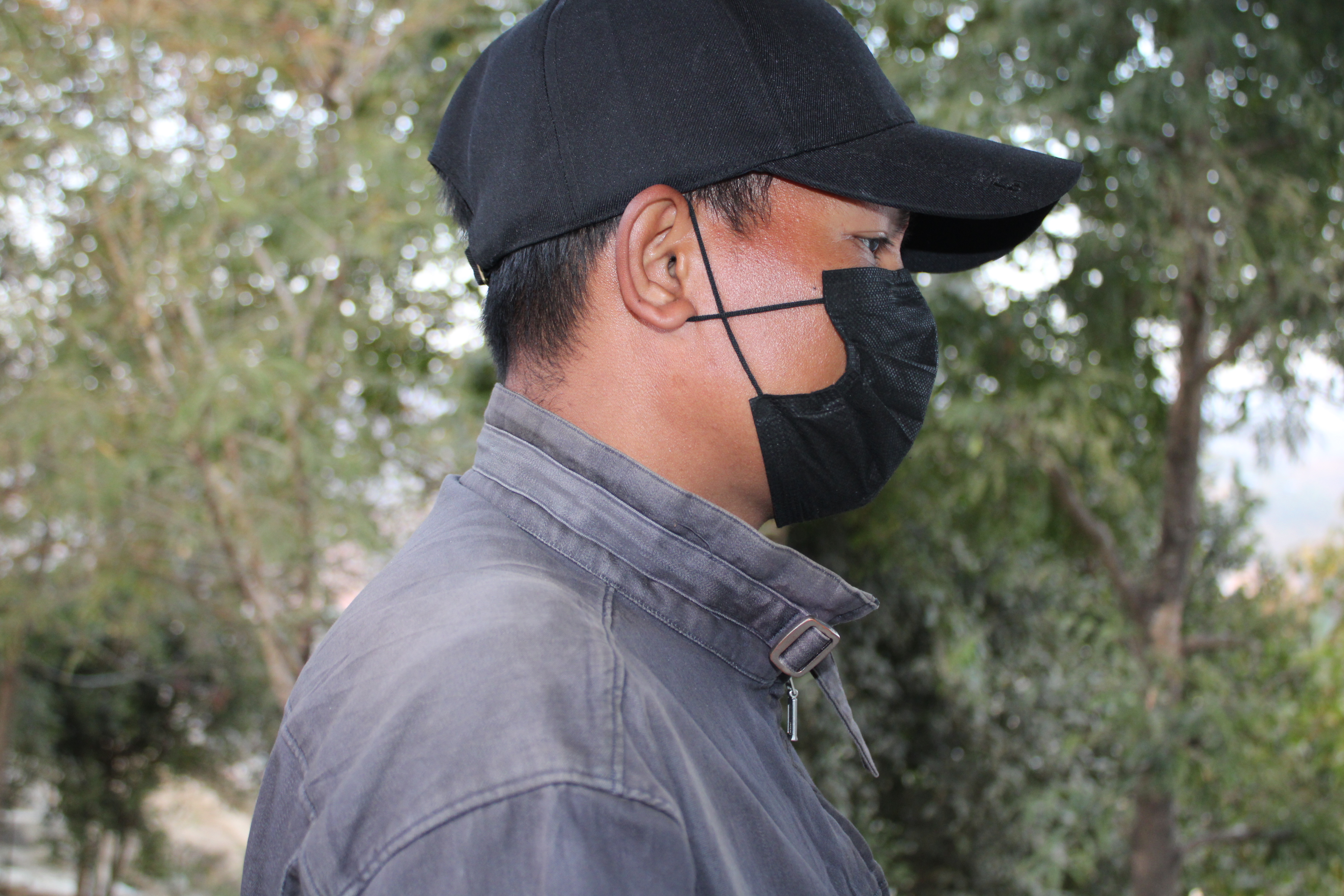
Thainglang Soe at the Tourist Lodge in Zokhawthar in India. Photo by Rajeev Bhattacharyya.
Thanlaing Soe, in his early 30s, is a wanted man in the eyes of the junta. On May 21, 2021, a poster was released at some locations, including Mandalay, with his photograph and the reasons that prompted the military to issue the notification.
Thanlaing Soe was posted in Magwe as a sergeant of the Myanmar army when the democratically elected government was toppled. He did not support the coup and suppression of democracy and had been thinking of deserting the army from the day the coup happened.
Thanlaing Soe narrated his escape in an interview at Zokhawthar on January 18:
“Our establishment was on top of a hill. I was in the squad of a dozen army personnel that had planted landmines at some locations below the camp, since there was a possibility of an attack by the resistance fighters. So, I knew the spots that were safe without landmines and the route to be taken during the escape, which would be possible only at night. But there were 80 soldiers in the camp. And I was always put on duty during the daytime.
The chance came on May 10, 2021, when the roster was changed and I was given the duty from midnight. I decided to take the plunge at 2 a.m. when my colleagues would be fast asleep and the other sentries would be relaxed. I had already chosen the spot from where to jump from the wall of the camp, which was about 25 feet from the ground.
My assessment was faulty in assuming that I would be able to escape without being noticed at all. I jumped with my MA-1 rifle, but the fall below created a noise, alerting my colleagues who were on duty. Within no time, there was a shower of bullets as I began to slide downwards almost vertically without thinking about the consequences. My immediate objective was to reach a spot about 50 feet below, which would be beyond the sight of the shooters. Somehow, I was able to do that but not before an injury on my left shoulder and right leg. Fortunately, my colleagues decided not to rush out of the camp to hunt for me.
I marched continuously the whole night to reach a destination 15 miles away where functionaries of the Yaw PDF lived. I handed my MA-1 rifle with all the ammunition to them. They took me to Camp Victoria [the military headquarters of Chin National Army] where I stayed for three days and met more people who had deserted the army. The PDF wanted me to join the group but I had decided to head to Mizoram for a job.
Since I escaped, some army officers had gone to my house at Mandalay to interrogate both my sisters for information about me. So far, they have not been harmed.”
“They told us to vacate the house within an hour as they had spotted an army column…”
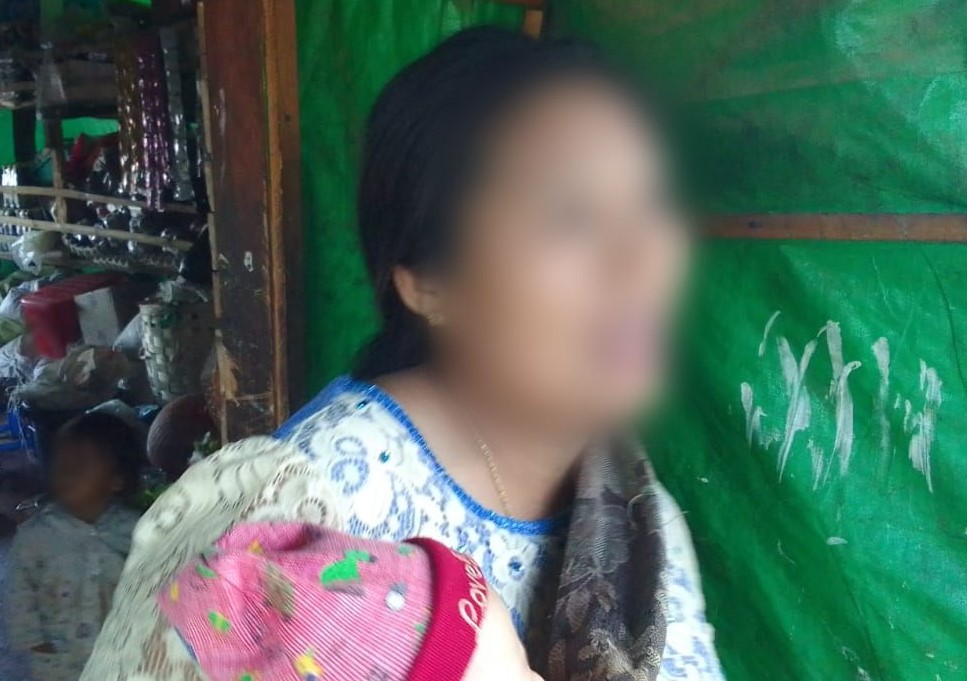
Khin Oo at an IDP camp in Salen of Chin State in Myanmar. Photo by Rajeev Bhattacharyya.
Khin Oo, 38, along with her five children and husband, arrived at the internally displaced persons (IDP) camp in Salen village of Thantlang township in Chin State on February 26, 2022, after a long and hazardous journey from her home located 200 miles away at Rizua. A resistance group called the Chinland Defense Force Matupi had been formed within three months of the military coup and the battlelines were being drawn for a clash with the military. Raids on and burning of villages had already started in Matupi township when Khin and her family scurried to safety in the nick of time. She was interviewed at the IDP camp in Salen on February 3.
“The incident happened on February 24 of last year. As usual, we had our dinner in the evening and the children had gone to sleep. I was chatting with my husband about how the situation could change in the coming days and if we would be able to continue staying in our village. A village, which was about 10 miles away from ours, had already been burned by the military and some people had been killed. There were some functionaries of the resistance group from that village.
There were not very many options that we could choose from and the only alternative would be to relocate to a safer place in the event of an attack. But we did not know where to go with the children.
Then, around midnight, after we had gone to sleep, there were continuous knocks on the door. I was scared. When my husband opened the door, two heavily armed resistance fighters barged in. They told us to vacate the house within an hour as they had spotted an army column on the other side of the river about 5 miles from our village. They instructed us to escape through a route that runs through the other end of the village. They also explained that residents of all the houses had been told to begin the march in a group for relocating to a safer place.
We packed whatever items we could in four bags. And within 45 minutes we were ready to hit the trail. The resistance fighters directed us to a spot where more families had assembled. We walked continuously for five hours quietly through forests and plains till we managed to find some vehicles in the morning to go to Thantlang as it was considered safer. We journeyed continuously the next day and reached Salen on February 26.
Some families that had relocated with us from Rizua have resettled in some other places. We hope to return to our village soon if the situation becomes normal.”
“I saw about a dozen military personnel spraying gas and burning a house. I knew I had to run.”
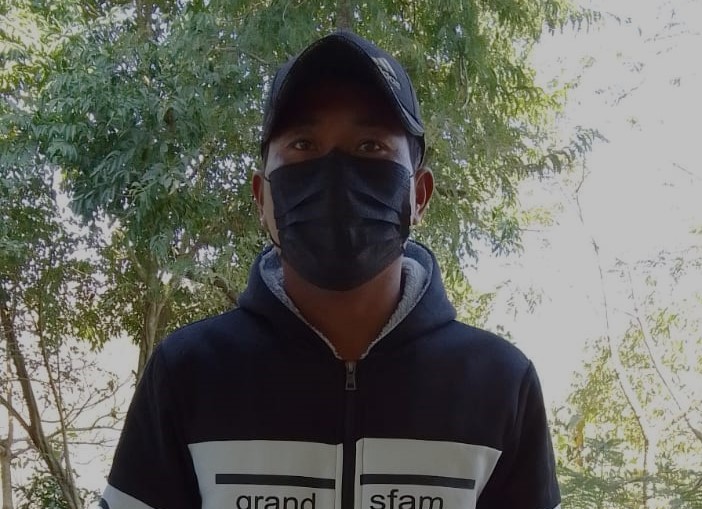
Salai Saite at Kalay in Myanmar after leaving his village. Photo by Rajeev Bhattacharyya.
Salai Saite, who is in his early 30s, was a teacher of mathematics and science at a government school in Kalay and a participant in the civil disobedience movement that erupted after the coup. He had assumed that his village, Sekan, would not be touched again by the regime forces since many houses had already been burned twice in 2021, on March 21 and October 21. Many residents had already relocated to safer zones in other parts of the district and Mizoram, but he decided to stay put at his home. But he was proven wrong in his evaluation of the military’s plans.
Saite was interviewed at a location in Kalay on January 20 as he was preparing to leave for Mizoram:
“Our village, Sekan, had about 2,000 residents. It was repeatedly targeted because many young people from this village had joined the resistance groups. In the two earlier raids, 82 houses were burned and one woman was killed while a man went missing. The forces had sprayed bullets for almost 10 minutes intermittently to instill fear among the residents. Almost 50 percent of the inhabitants of the village relocated after the raids in 2021. My family members. including my parents, left for a refugee camp in Mizoram.
On August 22 of last year, I was awakened at 5:15 a.m. by continuous screams, which was a bit unusual. From the window of my bedroom, I saw smoke and then some neighbors running at a frenetic pace as if they were running for their lives. When I opened the front door, one of them shouted, “Run! They have already killed three people.” Later, I came to know that among the people who were shot dead were two women and a child.
I saw about a dozen military personnel at a distance of about 500 feet from my house spraying gas and burning a house. I knew I had to run as well. I grabbed my wallet and whatever clothes I could gather in a couple of minutes in a bag and jumped from the rear window of the house. I walked for about 6 hours to reach a hideout of some resistance fighters, who wanted me to join them immediately. Instead, I decided to go to Mizoram and explore the possibility of getting a job.”
Postscript: Sekan was burned for the fourth time on January 23 this year. The village has been abandoned completely.
“He had a miraculous escape… He was also successful in his objective of flagging the danger.”
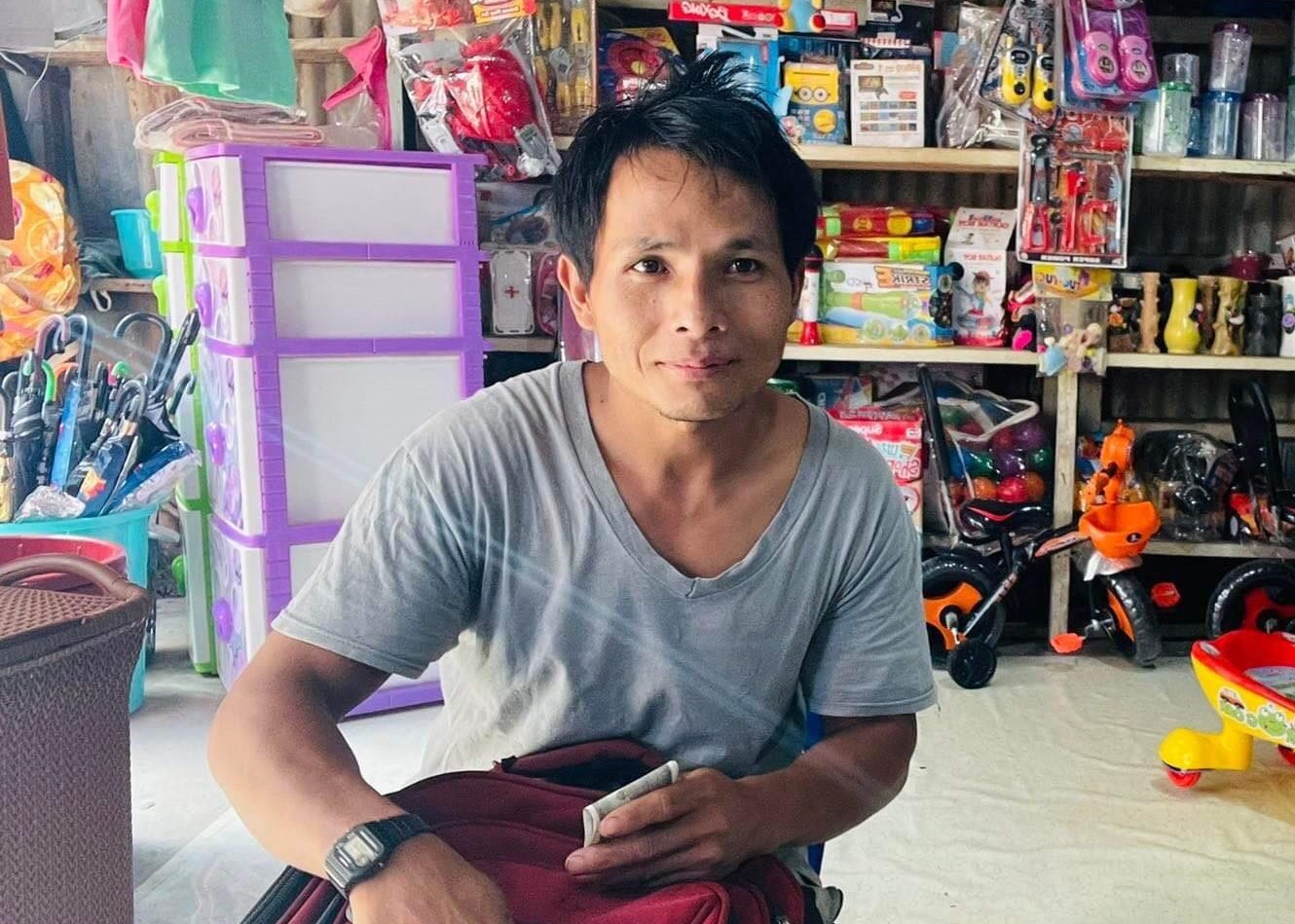
Salai Baite at Lawngtlai, India, after he escaped from Matupi in Myanmar. Photo courtesy of the Chin Human Rights Organization (CHRO).
Salai Bawite, 40, used to live in a village near Matupi in Chin State. He now lives with his family at Lawngtlai in the Indian state of Mizoram.
On January 6, 2022, he and some others were apprehended and about to be put before a firing squad. He not only managed to escape but also saved the lives of many people from his locality. After crossing over to Mizoram, he narrated the spine-tingling episode to Salai Mang Hre Lian, program manager of the Chin Human Rights Organization (CHRO). The details of his escape were gathered by this author after interviewing Lian on February 8 in Mizoram’s capital, Aizawl:
“The incident happened at a village about 8 miles from Matupi township on January 6, 2022. Ten people were killed when a village was raided by the regime forces. Salai Bawite was in a group of four persons who were able to escape unharmed from the village. They decided to head to a forest, which was about 3 miles from the village, thinking that it would be safe and beyond the range of the raiding party.
They did not know that a platoon had anticipated their movements and was hiding in the jungle. So the entire group was apprehended after they entered the forest and were compelled to kneel on the ground. The military planned to capture and kill everybody escaping through that route.
Bawite believed his end was near and decided to undertake a sort of “suicide attempt.” He assumed that if he ran away, he would be shot instantly but the gunfire would deter everybody else from the village from proceeding toward the forest. And so, he leaped away and ran at breakneck speed, prompting two personnel to pull the trigger immediately. A hail of bullets flew past him and some very close to his body. But he had a miraculous escape. He survived to tell his tale. He was also successful in his objective of flagging the danger in the jungle. No more people escaped on that route after hearing the gunshots. However, the others in his group were killed by the regime forces.













